

Camalie Vineyards is located 6 miles west of Napa on Mt. Veeder in the Mayacamas mountain range at the center of the Mt. Veeder Appellation. It consists of 4.4 acres of vineyards and 18 acres of forest. The land that Camalie Vineyards comprises used to be part of the ocean bottom. The soil is primarily clay. In many places the soil is 30 ft. deep on top of sandstone bedrock. Because of all this soil the earth here is always moving. The Mayacamas are known as the "walking mountains". They take a step every year as the soil gets drenched with 40 inches of rain in the winter and then proceeds to dry out during the 6 months of Summer and Fall when they see no rain at all. The deep clay soils hold a great deal of moisture throughout the growing season enabling the vines to survive with minimal irrigation once established. The roots reach depths of 5-6 feet but are mostly found 2-3 feet down. Optimal vitaculture still calls for significant irrigation. We use about 35 gallons of water per vine over the course of a growing season.
The first settlers on this land were the Simmons family around 1860 although we also have reports that they owned it as recently as 1974. Need to do more research here. They cleared the land and planted a plum orchard which supplied plums to Sunkist. A number of bearing plumb trees can still be found around the property. They dug a well by hand 25 ft. deep, lining it with stacked rocks at the site of a spring which supplied all the water they needed. This well is still intact and supplies 20% of the water we use for irrigation, about 55,000 gallons a year.
Various other people owned the property over the years. Bill and Susan Wright eventually ended up with the property around 1975 after his brother convinced him to buy the place. It was called Pickle Canyon Vineyards before they bought the place. The 'Wright Brothers' named it Kitty Hawk Vineyards.
Bill's brother, John Wright, worked for Anderson Consulting in New York before coming to California. Anderson was hired by Moet and Hennessy to explore their getting into the California Wine business. John Wright was assigned to the M&H account and did consulting for them eventually recommending their purchases of land in Napa. M&H hired John to manage their aquisitions and start up Domaine Chandon in California and as part of his compensation he ended up with the parcel adjacent to Camalie Vineyards to the North. Sometime in here he married Renate. The old cinder block building with our shop and agricultural equipment storage was the office where John managed most of the Domaine Chandon original start-up. John and a neighbor Michael Jones who was living on the Domaine Chandon property East of Kitty Hawk Vineyards made still red wines in this building. It includes a closet sized wine cellar. We made 5 barrels of wine in this garage in 2005 when we had an unexpected bumper crop of grapes in the second year after planting.
Around 1975 John convinced his brother Bill who was retiring from the CIA to buy the property. Bill and Suzy added a redwood hot tub to the old House and had numerous parties there which visiting Mt. Veeder old timers like Randle Johnson and James Konrad, frequently tell us about.
The Wright brothers planted the vineyard with Cabernet Sauvignon grapes in 1975 on St. George root stock, a very vigorous phyloxera tolerant rootstock which has enabled them to survive without irrigation for more than half their 34 year lives.
Suzy Wright eventually got tired of the remote living and in 1985 they sold the Kitty Hawk Vineyards to Dr. Woo and moved down into the valley.
Thoracic surgeon Dr. Russell Woo contracted the farming of the grapes for 7 years until the yield dropped below an economically viable level. Dr. Woo used the property primarily as a retreat from his busy San Francisco medical practice. He retained the name Kitty Hawk Vineyards.
Old
vineyard, Spring 2001. Planted 1975
In November of 2000 My wife Cindy and I, purchased the property from Dr. Woo and his wife and renamed it Camalie Vineyards which is a name formed from our kids names, Cameron and Natalie. We made wine from the limited grapes that were surviving on their own in 2001 with surprising success and started the process of developing water supplies and replanting the vineyard. We kept the best half acre of the old vines to practice winemaking and pulled out the remaining 3.5 acres of old vines in the winter of 2001/2002. The old vines were burned in huge bonfires and all of the wire of the old trellising hauled away for recycling. This was before it became fashionable to sequester carbon.
We engaged an architect to begin work on a design for a new home in 2001 and saw first plans in early 2002.
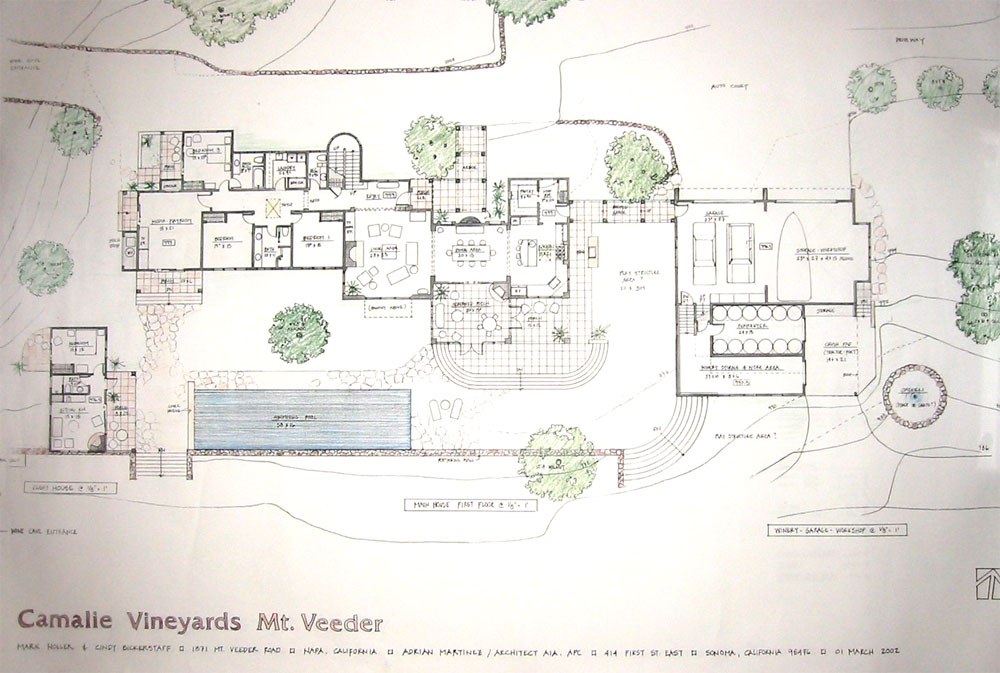
We sat on the plans for a year and just couldn't get excited enough to start the project.
In the summer of 2002 we installed our county approved erosion control plan and prepared the vineyard for replanting. This involved putting in drainage pipe and cultivating.
South Vineyard Ready for replant after erosion control put in.
In late winter 2001/2002 we laid out the new vineyard, marking each plant location with a plastic knife. Then end posts were pounded into place. At this point the irrigation submains were trenched in and risers placed for each row. Then the highway stakes were pounded in and wire run for cordons and irrigation hose. Training stakes were placed and clipped to the cordon wires. Irrigation hose was run and clipped to the irrigation wire. Holes were punched in the irrigation hose and drippers installed.
To hold the soil in place through the winter of 2002/2003 we planted a cover crop and applied a layer of hay to hold the soil in place while the cover crop had a chance to take root. In the spring of 2003 we set the new vines in place.
Ramon
Pulido, Vineyard Manager on right planting March 2003.
We were very fortunate to find vineyard manager Ramon Pulido who has guided us through the process of growing grapes and replanting the vineyard. He has been extremely successful in getting the yields up. In 2001 before he got involved the yield for the whole 4 acres was 3/4 ton. The following year with a little fertilizer and water we achieved 3/4 ton from just the 1/3 acre of vines we had saved for posterity. In 2003 the yield further increased to 1 ton in spite of losing another dozen of the 325 vines. In 2003 we brought 2 new wells online, installed an irrigation system including a 10K gallon water tank and fertilizer insertion capability and automatic timer.
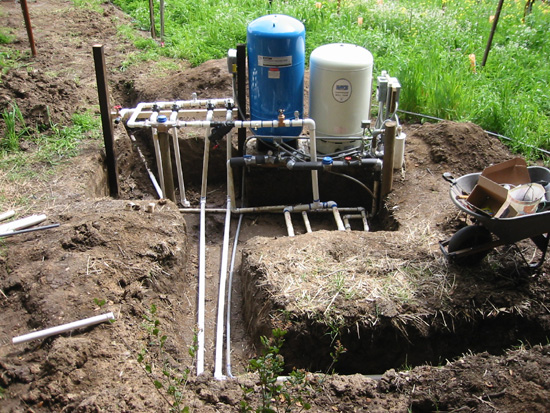
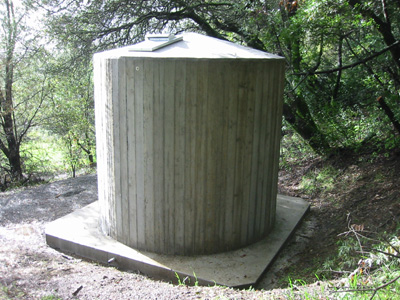
Irrigation distribution system.

One year old replanted vineyard January 2004 , 360 degree panorama.
The winemaking has had an interesting evolution. In 2001 we hacked through the blackberries to pick the grapes that had grown in the vineyard despite 7 years of complete neglect. The Advanced Winemaking class at Napa Valley College gave us enough knowledge as we made Pinot Noir in class to make cabernet that year 2 weeks behind the winemaking in class. This was just in time learning. 2001 I enlisted two of my neighbors in this risky venture to make a barrel and a half of Cab never having made wine before except for that bottle I made from some Welches grape juice and red star yeast when I was 12.
Part of our success was some significant planning which was enabled by my retirement from Intel in the Spring of 2001. The original Winemaking Proposal was an engineer's approach to a new project. No time for apprenticeship here. Neighbor's Gary Bacon and Tim Guilford were enlisted and the Forest Ave. Wine Coop was born.
In 2002 the vineyard had been ripped out except for the old guys but we wanted to make more wine so we bought grapes from our neighbor Domaine Chandon who had started planting cab a couple years prior. We were very lucky to get the first crop from their 2.5 year old French clones for only $2.5K/ton. These grapes made the fabled 2002 barrel WC5 which has been consistently our best liked wine in blind tastings against anything.
In 2003 I got sloppy with my feeding of the yeast and ended up with sulfides, then mercaptans and finally disulfides all of which smelled very bad. I ended up dumping 1.5 barrels of this wine down the drain. Fortunately the co-op wine didn't have this problem although the grapes were picked early and this wine tends to be fairly vegetative. Cindy retired from Intel this year.
In 2004 we were still not picking ripe enough. We bought grapes from Rubissow and fed the yeast diligently avoiding any sulfide problems. All of the wine this year was made in Palo Alto.
In 2004 we hired M. Dean Jones to design a remodeling of the garage which was constructed in the summer of 2005. We also began excavation of a 1500 sq. ft. cave in the summer of 2005. The plans for the home by the first architect we engaged just didn't excite us enough to justify the resources required to make that design happen. Something was missing. The idea of building a green home was the result of Cindy's reading and discovery of this movement. Cindy found Arkin-Tilt architects at a sustainable living conference in Hopland and we engaged them to design a new "green" home for the site. As we were redeveloping the vineyard and garage and putting in a cave it was clear to us that we were making some significant changes to the environment. We were sensitive to this and wanted to minimize our impact, living in a way that wouldn't change the beautiful environment there long term. To avoid changing the global environment we decided to build a home that would not use any fossil fuels. Solar energy and dead wood from the 18 acres of forest on the property were to be the energy sources for the home. Solar would be our first choice to minimize our carbon footprint. We decided to stop the policy of burning our prunings again to reduce our carbon footprint. We opted for a smaller home integrated well in shape and placement with the hillside. In April 2005 we had first plans for the home from Arkin Tilt.
2005 was the "Crush amid Chaos". The chaos was the result of having to demolish the old house in the midst of harvesting a huge unexpected crop (4 tons) for a two year old vineyard, and making wine from it. We couldn't let this awesome first crop go to waste so we expanded the co-op in Palo Alto to 12 members/4 barrels and started up a second one in Napa which ended up making 5.5 barrels. This was a wise decision because all of the wine we made that year is awesome. Samples from the barrels helped us get three offers for the grapes the next year. We held the harvest party on the dirt floor inside the cave with Christmas lights strung up and down the tunnel.
We thought we were close enough to completing our plans and getting them approved that we felt comfortable demolishing the old house in the fall of 2005. It allowed us to do some grading work in preparation for the new home's foundation. As it turned out we weren't that far along. It wasn't until March of 2006 that the plans were ready for submission to the county at which point we found out that the queue for approval was 12-14 weeks long. It ended up taking us until 8/21/06 to get them approved, almost 5 months. We missed most of the 2006 construction season because of this delay but, were able to get the foundation largely done that fall. Light rains that winter allowed us to make good progress on getting the Tri-D panels up and ready for shotcrete the following Spring.
In 2006 the vineyard yield doubled to 8 tons and this time we found a buyer, in fact 3 offers thanks to our good neighbors' referrals. We scaled back the coop size and had one of our lowest stress crushes yet except for the rodent from hell that ate the fuel injector wiring harness on my F350 Pickup the day before harvest. David Provost saved the day by lending us his truck.
The swimming pool was complete in time for swimming on the 4th of July, 2007.Construction continued throughout 2007 and 2008 finishing up around harvest of 2008, three years from the date we demolished the old home. This was about a half year longer than anticipated and significantly over budget.
In 2007 the yield doubled again to 17 tons this time almost reaching 4 tons/acre which is very rare on Mt. Veeder. Our winery customer complained about the unexpected volume but, accepted it in the end. Rains before harvest suppressed the brix levels but, the last 3.5 tons to go were at 29.7 Brix. The cave was complete except for doors so we moved the co-op to Napa. The Merlot yield was very high producing almost 2 barrels of wine while the Carmenere fruit set was poor producing only a quarter barrel of wine from the same number of vines as the Merlot. Our wireless soil moisture sensing network was critical as the previous winter's rainfall was half of normal and we had to truck water for irrigation at the end of the season.
In 2008 we had frost in the spring and yield fell off significantly back to 9 tons.
We joined the Mt. Veeder Appellation Council and Mark became its Vice President in 2008. We have since hosted several Council meetings at the new home and made numerous contributions to the new Appellation Website.
In 2009 we have for the first time been able to enjoy the new home with all of the development done except for some landscaping.
Our focus was simple; raise our kids, grow the best grapes and make the best wine with the best of friends in a way that respects this beautiful spot on Mt. Veeder and the planet. Set an example for others if we can.
In 2015 we finished the bulk of raising our kids as Natalie went off to school and with Cindy's loss of interest in wine we have decided to part company as of this April 2016. I'm now living full time at Camalie and hope to be able to continue doing so but, only time will tell.
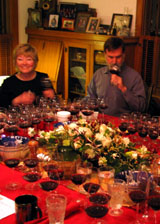 Glista
and Tim, Best of Friends.
Glista
and Tim, Best of Friends.
Walking up to the front door of the old residence. It was demolished in Oct of 2005 to make way for a new home.

Upper Vineyard of 25 year old Cabernet Sauvignon Vines. Also the Garage/Workshop/Ag shed and the indispensable 1984 Toyota Pickup truck.
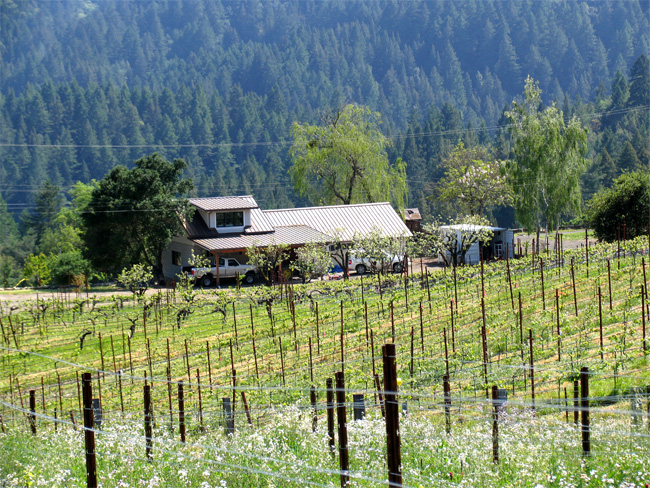
After remodeling the garage and upgrading to Ford F350 pickup. Spring 06
The newly roofed cistern/well and our vegetable garden. Summer 2002.
Acknowledgements: Special thanks to Randle Johnson and Mike Morris for filling us in on the history of this parcel before it is lost.
Last edited 6/2/16, M.H.
More Mt. Veeder History Reprinted below so it doesn't get lost with the next update of the NorthBay biz website.